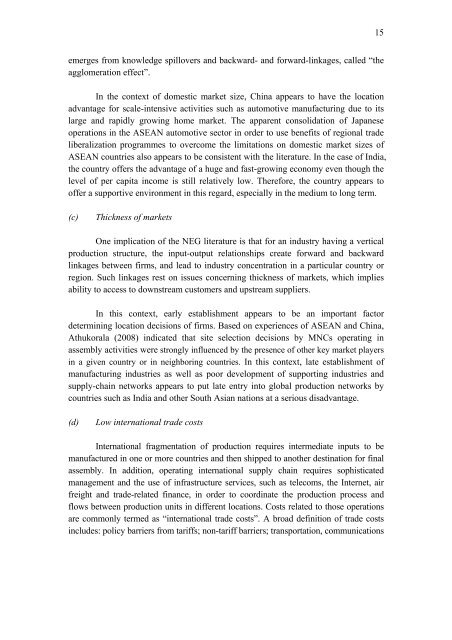Chapter I Driving forces of Asian international production ... - escap
Chapter I Driving forces of Asian international production ... - escap
Chapter I Driving forces of Asian international production ... - escap
You also want an ePaper? Increase the reach of your titles
YUMPU automatically turns print PDFs into web optimized ePapers that Google loves.
emerges from knowledge spillovers and backward- and forward-linkages, called “the<br />
agglomeration effect”.<br />
In the context <strong>of</strong> domestic market size, China appears to have the location<br />
advantage for scale-intensive activities such as automotive manufacturing due to its<br />
large and rapidly growing home market. The apparent consolidation <strong>of</strong> Japanese<br />
operations in the ASEAN automotive sector in order to use benefits <strong>of</strong> regional trade<br />
liberalization programmes to overcome the limitations on domestic market sizes <strong>of</strong><br />
ASEAN countries also appears to be consistent with the literature. In the case <strong>of</strong> India,<br />
the country <strong>of</strong>fers the advantage <strong>of</strong> a huge and fast-growing economy even though the<br />
level <strong>of</strong> per capita income is still relatively low. Therefore, the country appears to<br />
<strong>of</strong>fer a supportive environment in this regard, especially in the medium to long term.<br />
(c) Thickness <strong>of</strong> markets<br />
One implication <strong>of</strong> the NEG literature is that for an industry having a vertical<br />
<strong>production</strong> structure, the input-output relationships create forward and backward<br />
linkages between firms, and lead to industry concentration in a particular country or<br />
region. Such linkages rest on issues concerning thickness <strong>of</strong> markets, which implies<br />
ability to access to downstream customers and upstream suppliers.<br />
In this context, early establishment appears to be an important factor<br />
determining location decisions <strong>of</strong> firms. Based on experiences <strong>of</strong> ASEAN and China,<br />
Athukorala (2008) indicated that site selection decisions by MNCs operating in<br />
assembly activities were strongly influenced by the presence <strong>of</strong> other key market players<br />
in a given country or in neighboring countries. In this context, late establishment <strong>of</strong><br />
manufacturing industries as well as poor development <strong>of</strong> supporting industries and<br />
supply-chain networks appears to put late entry into global <strong>production</strong> networks by<br />
countries such as India and other South <strong>Asian</strong> nations at a serious disadvantage.<br />
(d) Low <strong>international</strong> trade costs<br />
International fragmentation <strong>of</strong> <strong>production</strong> requires intermediate inputs to be<br />
manufactured in one or more countries and then shipped to another destination for final<br />
assembly. In addition, operating <strong>international</strong> supply chain requires sophisticated<br />
management and the use <strong>of</strong> infrastructure services, such as telecoms, the Internet, air<br />
freight and trade-related finance, in order to coordinate the <strong>production</strong> process and<br />
flows between <strong>production</strong> units in different locations. Costs related to those operations<br />
are commonly termed as “<strong>international</strong> trade costs”. A broad definition <strong>of</strong> trade costs<br />
includes: policy barriers from tariffs; non-tariff barriers; transportation, communications<br />
15

















